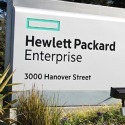The IT company needs to slash costs and fatten its aaS offerings if it is to keep investors as happy as they are right now.

Investors could have done worse than to buy shares in HPE last year. Had they done so in late October, after the stock had pootled along for months at the $9 or $10 dollar mark, they would have seen the value of their investment rise 68%. No member of the FAANG club even comes close.
Yet the company's recent financials are hardly cause for Wolf-of-Wall-Street bacchanalia. Total revenues slipped 1.7% for its January-ending quarter, to about $6.8 billion, compared with the same period a year earlier. Net profit sank a third, to $223 million. That HPE has topped third-party expectations shows how low the bar is set.
Even so, this is a much better start to the fiscal year than HPE had in 2020, when its corresponding first-quarter revenues fell 8%. Three months after that, a 16% drop in quarterly sales led to an $821 million loss. HPE's share price fell 11% after that particular update as CEO Antonio Neri moaned about the impact of lockdowns on his business.
Figure 1: HPE six-month share price in New York ($)  Source: Google Finance
Source: Google Finance
He was in a bubblier mood on the latest call with analysts as the hair-raising descent of last year seemed to bottom out. The only meaningful growth came at HPE's Intelligent Edge business, reflecting the world's interest in sticking cloud technologies everywhere. Sales at that division were up 12%, to $806 million.
There were some other glimmers, too. Neri is evidently excited about HPE's latest telecom offerings, including an obligatory open RAN "solution stack" (mainly a new server with an unmemorable name) and a set of 5G core network products. It was too early for those to make any visible contribution, but core trials with France's Orange – "in preparation for broader commercial deployment" – sound promising.
More generally, revenues from as-a-service (aaS) products are rising quickly. While HPE does not appear to break these out on a quarterly basis, the annual run rate was up 27%, to $649 million. Announced in 2019, the grand plan is to make an aaS of everything. Instead of buying a server and taking out a software license, a customer could effectively subscribe to a HPE package that includes hardware, software and service management. Under the plan, HPE will be able to sell all products this way by 2022.
Does my aaS look big in this?
That is the vision, anyway. The unfortunate reality is that aaS still accounts for a tiny fraction of total sales. In fact, the annual run rate of $649 million shared on HPE's earnings call equals only 2.4% of entire company revenues last year. Nor is aaS growth filling the hole that has opened up as other sales have receded. In 2018, HPE was a $31 billion company. Last year, it was $4 billion smaller, and the decline continues.
Other IT companies face the same dilemma. Take Deutsche Telekom's T-Systems unit, for instance. Its cloud services represent the fastest-growing part of the whole group, with sales up 30% last year, according to Christian Illek, Deutsche Telekom's chief financial officer. And yet total T-Systems revenues fell 5.6% in 2020, to about €4.2 billion ($5.1 billion), while operating losses widened by �€225 million ($271 million), to €650 million ($783 million).
Want to know more about 5G? Check out our dedicated 5G content channel here on Light Reading.
HPE, at least, is not loss-making. It is also now guiding for a 20% increase in underlying operating profits this year, an improvement that would deliver more than $2.4 billion in total. This, however, would be well below the $2.75 billion that HPE made in the 2019 fiscal year, even though HPE's operating margin rose to 11.3% in the recent first quarter, from 7.4% for the whole of 2020.
Profitability has improved thanks to aggressive cutbacks designed to reduce annual costs by $800 million between 2019 and 2022. Where things stand on this program is not entirely clear. "The $800 million net run rate benefits, as a reminder, would be felt for the most part in fiscal year '21," said Tarek Robbiati, HPE's chief financial officer, on the earnings call. "You started seeing some of that."
What's very clear is that HPE's workforce shrank by 2,200 jobs last year, nearly 4% of the total, and 6,600 roles have disappeared since 2017, or one in ten. Its previous effort to save $800 million a year came at a net cost of 6,000 jobs in 2018. As investors smile, employees affected by the latest cuts may think HPE is a different kind of aaS.
Related posts:
— Iain Morris, International Editor, Light Reading
About the Author(s)
You May Also Like











